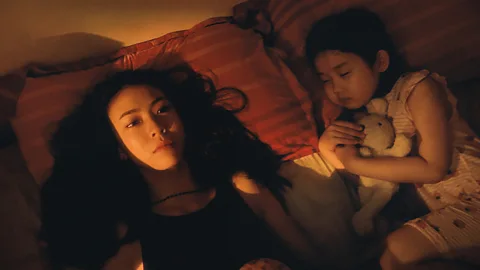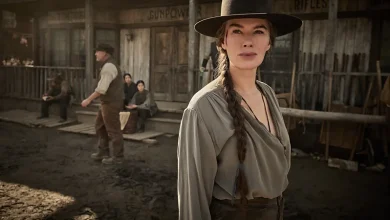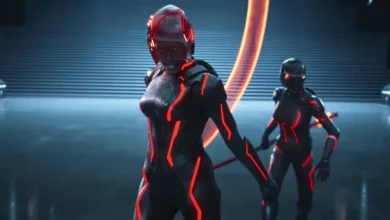‘It’s the devil’s hand’: The acclaimed new film exploring the myths about left-handed people

Left-handedness is often seen as being “wrong” – and also as a sign of “genius”. Shih-Ching Tsou’s drama, Left-Handed Girl, draws on the prejudice she faced as a leftie in Taiwan.
In the acclaimed new film Left-Handed Girl, a Taiwanese five-year-old named I-Jing is scolded by her grandfather when she uses her left hand for drawing. He tells her that it’s “the devil’s hand”. Later, while her mother and adult sister work long hours, I-Jing steals from the market stalls near the family’s tiny apartment, blaming her crimes on her “wicked” left hand. Many people, it seems, imagine that being left-handed is not quite right.
Around one in 10 people are thought to be naturally left-handed, but for centuries it was seen as inherently wrong, even evil: both the Bible and the Quran have negative passages about the left-hand side; the Latin word for left is “sinister”; and even when no longer associated with witchcraft, it was seen as something that needed “correction”.
But over the last few decades in the West, left-handers have come into fashion: they are often said to have greater levels of creativity, and even genius, than their right-handed counterparts. There’s an International Left-Handers Day, and there are lists of famous left-handers that include Sir Paul McCartney, Leonardo da Vinci, Prince William, former US President Barack Obama and Lady Gaga. Left-handers may still live in a right-handed world, but in some places, they (or rather we) can feel part of a talented minority.

The director and co-writer of Left-Handed Girl, Shih-Ching Tsou, is based in New York, but her film (her solo directing debut) is a comedic and heartfelt exploration not just of being left-handed, but of her native Taiwan. She’s also the producer of some of Oscar winner Sean Baker’s best-known films, including Tangerine, Red Rocket and The Florida Project; and Baker co-wrote and edited Left-Handed Girl.
She tells the BBC that the film, selected for the Cannes Film Festival and as Taiwan’s 2026 entry in the best international film category at the Oscars, stems from her own childhood. Growing up in Taiwan, she was naturally left-handed, but as an infant was encouraged to use her right hand instead. Now, she says, she only uses her left hand to hold a knife or scissors.
When you’re a young kid growing up, you’re told not to be different, and it really affects you – Shih-Ching Tsou
“I was born left-handed and this film started from something my grandfather told me when I was in high school,” she says. “He told me that the left hand is ‘the devil’s hand’ and he asked me not to use it, although by that point, I wasn’t left-handed anymore. When I met Sean at an editing class in 1999 in the US, I told him what my grandfather had said, and he thought it was a wonderful idea for a story because of this idea of a taboo. We even went to Taiwan in 2001 and shot some pictures and made a trailer, but at this point, we didn’t have the resources to make a movie.”
Tsou adds that I-Jing’s left-handedness is a metaphor for the real point of her film: the idea of conformity in Taiwan, and the pressure, especially on women, to behave in a certain way in a patriarchal society.
“Throughout the years before I made this, I kept on telling Sean that I really want to tell a story about women. The way I grew up in Taiwan, there’s a lot of expectations, a lot of limitations that we put on girls. You have to be a certain way, you have to fit in, you cannot stand out. Especially when you’re a young kid growing up, you’re told not to be different, and it really affects you. This is more than left-handedness; it’s a story about how you cannot be yourself.”
Casting a left-handed actor
In 2023, Taiwan still had some of the lowest reported rates for left-handedness in the world, at around 5%. Nearby China was the lowest, at 2.64%. By contrast, nearly 13% of people in the Netherlands were reported to be left-handed, and the world average is 10.6%.
Tsou says that children in Taiwan are still being taught to use their right hand instead of their left, especially by people of older generations. “Before I made this film in Taiwan, a lot of people told me, ‘Oh, your story is so old because the left-handed taboo doesn’t exist anymore’,” she says. “But I told them, ‘Well, it’s my story and I’m going to tell it’. Then when I cast Nina Ye [the young actor who plays I-Jing] in 2022, she was six years old, and her mother told me on the first day that Nina was naturally left-handed but had already been ‘corrected’ by her grandmother, who didn’t like the idea of it. So, when Nina was on set, we had to retrain her to use her left hand for things like drawing and throwing a ball. We constantly needed to check whether she was using the correct hand for a scene or not.”

The idea of the left being somehow “wrong” is still present in Chinese and Taiwanese culture. According to a 2013 study on the topic by Howard Kushner, Emeritus professor of Science and Study at Emory University in the US, the Mandarin character for “left” can be translated as “weird”, “different”, “incorrect”, “contrary”, or “opposite”. Many Asian (and African) cultures traditionally use the right hand to eat, and only use the left hand when something is dirty. Kushner points out that the Mandarin character for “right” means “to eat with the right hand”.
Kushner, also the author of a book on the history of left-handedness, On the Other Hand, tells the BBC that the current low rates of reported left-handedness in these countries derive from practical reasons linked to industrialisation and education.
Left-handed sports stars have the benefit of surprise over (mainly) right-handed opponents
“Culturally, if you have a whole society that you’re trying to modernise relatively quickly, you won’t like around 10% of them needing to use the other hand in a big industrial setting, or a factory, or indeed a school,” he says. “There’s no advantage to it. And even imagine an agricultural setting before machinery, and you’re using a scythe, would you want to be standing in a line with someone next to you holding their scythe in a different hand?”
Kushner adds that, historically, left-handers had their biggest advantage in the military because, in hand-to-hand combat, right-handed soldiers would be less familiar with their attack patterns (it’s claimed that Napoleon was left-handed). Now it can be left-handed sports stars, such as Martina Navratilova and John McEnroe, the tennis champions, and Manny Pacquiao, the boxer, who have the benefit of surprise over (mainly) right-handed opponents.
Strangely enough, another tennis champion, Rafael Nadal, is naturally right-handed, but he holds the racquet in his left hand. Kushner says that in table tennis or ping pong, considered China’s national ball game, “left-handers can sometimes have a great advantage, and up until recently Chinese players were denied that”.

The current reported rates of left-handedness in some parts of Asia are comparable to those of Victorian Britain in 1900. Chris McManus, Emeritus professor of Psychology at UCL London, and the author of a book on handedness, Left Hand, Right Hand, says that rates of left-handedness among those born in 1900 dropped to 3% due to industrialisation. “No one was going to make a Spinning Jenny or other pieces of machinery for left-handers,” he says.
How the ‘creative leftie’ emerged
Ironically, the queen for most of this period, Victoria, was believed to be a natural left-hander who wrote with her right hand but painted with her left. But her great-grandson, George VI, is one of the best-known victims of early 20th Century “retraining” methods, which could involve tying the left hand behind a child’s back or to their desk. Some physicians equated left-handedness with becoming what they called “feeble-minded”, and, even later in the century, left-handedness was linked to schizophrenia and early death. It’s thought that George VI’s famous stutter, depicted in the film The King’s Speech, may have started when the “correction” did.
The positive idea of the so-called “creative leftie” or “leftie genius” only emerged, McManus says, in the 1960s and 1970s, when more research on the different hemispheres of the brain emerged, and featured in bestsellers such as Betty Edwards’s 1979 book on creativity, Drawing on the Right Side of the Brain.
“Right-handers use the left side of their brain to control their hands and speech,” he says, “and during this era it was also realised that the right side of the brain was more involved in activities such as visual processing, and aspects of speech. The idea gathered that the right side of the brain is more creative, and when it was found that left-handers use the right half of their brain for controlling their hands, people said, ‘Oh, left-handers must be more creative.’ You can see the steps in false logic running down this one. And it became a myth. You ended up with 1960s T-shirts saying, ‘I must be in my right mind because I’m left-handed.'”
Most recently, a 2025 study by Cornell University has debunked this theory by claiming that apart from art and music, left-handers are under-represented in all creative fields compared to right-handers, but, as McManus says, “like all good metaphors, it’s one that runs and runs. People like the idea and you can’t get rid of it.”
Still, maybe Tsou’s film will help to dispel some of the myths about being left-handed, both the positive and negative ones. And for Nina Ye, playing I-Jing has been, if not life-changing, then certainly hand-changing.
“After the Cannes Film Festival this year, we went back to Taiwan, and Nina had a playdate with my own daughter,” Tsou says. “And so, I asked Nina’s mum, ‘How’s the left-hand situation going?’ And Nina’s mum said that due to making Left-Handed Girl her grandmother’s given up, she’s not being ‘corrected’ anymore. So, Nina has her left hand back.”
Left-Handed Girl was released in cinemas on 14 November in the US and UK, and is on Netflix from 28 November.










